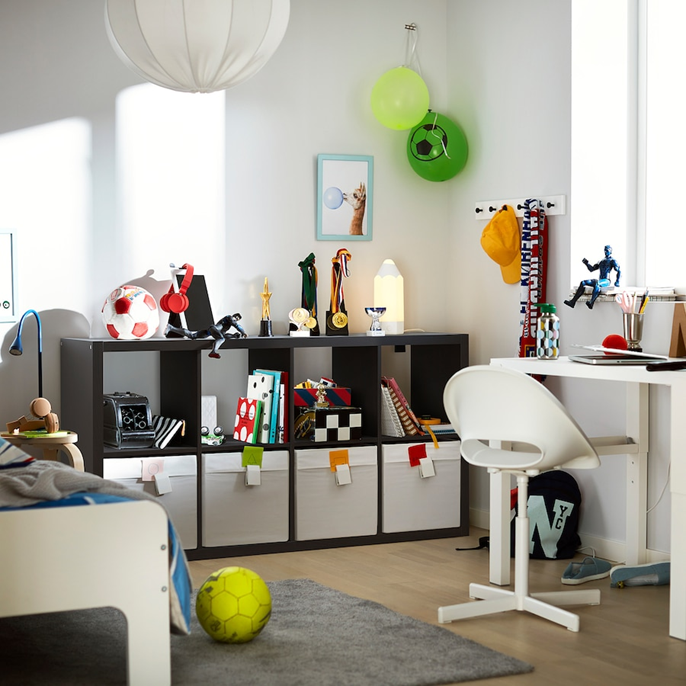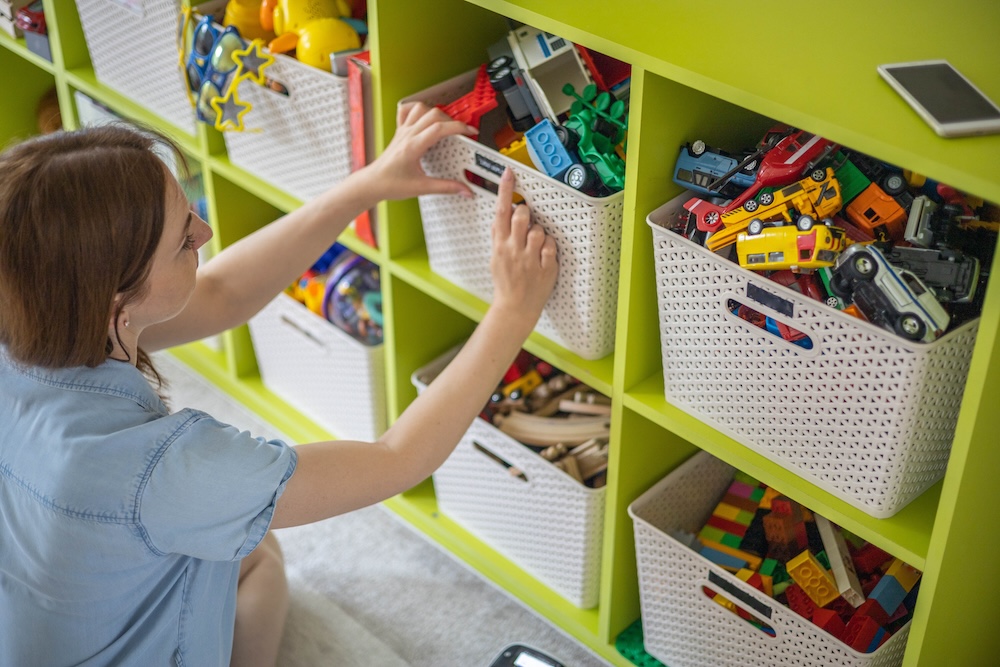The chaos of kids’ toys strewn about the house can feel like an unstoppable force that cannot be contained. But there is another way…
Transforming your child’s room into an organized space can seem quite a challenge at first — it’s up to you to make it both fun and practical. Plus, you’ll need to set your children up for success so that they can do their part to maintain a clean and tidy play space.
Effective Storage Solutions for Organizing Kids’ Toys
So where to begin? It is all about using the right storage solutions effectively. We handpicked the best toy storage ideas out there and made sure that you can get good use out of them for years to come.
Shelving Units
Use wall space to the max with shelving units — they’re great for books, decorative items and keepsakes. Going for a modern look? Consider floating shelves. You can even make them yourself and install them in every empty corner. No matter what you choose, it’s important to not think of shelving units in a child’s room as plain static furniture; the truth is they evolve with your child’s changing needs and interests.
| WHO | WHAT | WHERE | WHY |
| Toddlers | Board books, chunky puzzles and larger toys | Low, sturdy shelves with easy access | Encouraging them to explore and choose their activities |
| Elementary students | Various collections, from action figures to science kits | Adjustable shelving units | Can be reconfigured to accommodate items of varying sizes for their diversified interests |
| Tweens and teens | A mix of books, art supplies, trophies or model builds | More sophisticated and taller shelving units | Reflecting a more mature room layout, where they can display personal interests and achievements |
Montessori Shelves
Montessori principles focus on creating a child-centered environment that encourages learning and independence, which is why these shelves are designed with a child’s autonomy in mind. Even though they are toy storage solutions at their core, you could almost call them educational tools.
Widely available in a lot of designs and only a click away on Amazon, they tend to come with a hefty price tag. But a shelving unit doesn’t need to be advertised as Montessori to bring you all the benefits of this system. It’s enough to follow these principles (some derive from the furniture design, others from how you use them as toy organizers):
- Accessibility. Shelves should be at the child’s height, allowing easy access to toys and materials without adult assistance, thus fostering their independence.
- Order. Each item has a specific place on the shelf, promoting a sense of order and helping children learn to organize and maintain their space.
- Simplicity. Avoid overcrowding shelves. A minimalistic approach encourages children to engage deeply with the toys and materials available to them.
- Variety and rotation. Offer a variety of activities and regularly rotate them to maintain the child’s interest and encourage the exploration of new skills.
For these reasons, many parents and caregivers swear by the Ikea KALLAX shelf unit (laid horizontally). Low and open, it invites little ones to choose their activities and learn responsibility through self-guided play. All you have to do is arrange items in a way that makes them easy to see, reach and return after play.
Toy Bins and Baskets
Shelves are great for stacking but in a toddler’s bedroom, toy bins and baskets are the real deal and often work together hand-in-hand. They keep toys organized and accessible, where you can’t see or step on them.
- For infants and toddlers, safety and simplicity are key. Choose soft, open-top bins and fill them with plush toys, rattles and other safe, age-appropriate items that they can use as they please. Place the bins at ground level where little ones can easily reach in and find their favorite toy.
- Preschoolers start to categorize their world, so consider using toy bins and baskets to teach them sorting skills. Have separate bins for different types of toys — one for cars, another for blocks, and so on. Label them with pictures to help your child understand where everything goes.
- Once they reach elementary age, children have more complex toys. Consider stackable bins for compact organization, label them clearly and use them to store sets of toys, like LEGO bricks or crafting materials.
- As kids grow into tweens and then teens, their toys turn into gadgets, sports equipment and hobby supplies. Choose larger baskets that match their room’s decor or, better yet, let them have a say in the design choice.
Need extra tips? Invest in sturdy bins and baskets that can withstand daily use and are easy to clean. Use the right size baskets and they can be stored conveniently on shelves. Keep frequently used items in lower bins for easy access, and less-used items up high. Rotate toys in and out of bins to keep things fresh without overwhelming your child with too many choices at once.
What about all the special toy bins and baskets out there? Dare to go beyond classic and complete your toy storage collection with toy organizers designed with a specific purpose in mind. For instance, an all-in-one toy basket that comes with a play mat attached to the lid or a zoo-type storage cage for all the stuffed animals in the house.
Under-Bed Toy Storage
Of all toy room organization ideas, nothing says “efficient space usage” quite like under-bed storage — it’s like discovering a secret room in a child’s bedroom. While this type of space is more often used to store out-of-season clothes and extra bedding, it can be a great home for seasonal or less frequently used toys, as part of a toy rotation scheme or even incorporated into an easy cleanup routine kids follow before going to bed.
Now, from rolling bins to custom-built drawers, you can find or create under-bed storage solutions that fit perfectly with your child’s bed and room decor. Here are the best toy storage ideas to consider for that unused space under the bed, and remember, customization is key:
- Storing small items? Use dividers inside the bins or drawers to keep toys organized and easier to find.
- Clearly label each storage container, especially if they’re going to hold a variety of toys.
- Ensure that any under-bed storage is easy to pull out and push back in, avoiding any sharp edges or hard-to-manage mechanisms.
- Periodically check under-bed storage to reorganize and declutter. It’s easy for these spaces to become a forgotten stash of unused toys.
Closet Organization Ideas
If you struggle to find room for the large amount of toys and keepsakes that spark joy, it’s worth repurposing a closet — or at least a part of it — into a well-organized toy storage. Closets aren’t just for clothes and shoes, after all. Here’s what it takes to nail this project:
- Adjustable shelving. By customizing the height of shelves, you can accommodate toys of different sizes, from board games to basketballs.
- Hanging organizers with pockets. Use the vertical space on the closet door and fill it with small toys, action figures or craft supplies.
- Drawer units. If your closet has enough space for them, nothing beats drawers for storing puzzles, art supplies or electronic games.
- Clear storage boxes. Great for grouping toys, they make it easy to see what’s inside without having to open each box.
Pro tip: Keep similar toys together and ensure that frequently used toys are within easy reach. Avoid stacking heavy boxes or items that could topple over.
What Toy Organizers Do You Fancy?
We’ve searched high and low for the best toy storage ideas on the market and the bottom line is each storage solution has its perks. In the end, it all boils down to what makes more sense for your kids in each stage of their childhood. The idea is that every toy or activity your child owns, there is a special place that it returns to when they are done using it.
Go ahead and mix and match bins and baskets, shelving units and under-bed storage until you get the right formula for your family. There’s no wrong or right — just focus on safety first and the declutter will follow.




